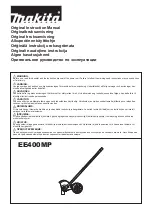
16
Subject to change without notice
circuit will wait for a new trigger, consequently the auto trigger
circuit will start the time base irrespective of the signal. Hence
the the display will not be triggered and free run, quite inde-
pendent of the signal’s amplitude which may be much larger
than the minimum.
Also in auto peak trigger mode, the trigger level control is active.
Its range will be automatically adjusted to coincide with the
signal’s peak to peak amplitude, hence the name. The trigger
point will thus become almost independent of signal amplitu-
de. This means that even if the signal is decreased the trigger
will follow, the display will not lose trigger. As an example: the
duty cycle of a square wave may change between 1:1 and 100:1
without losing the trigger.
Depending on the signal the LEVEL A/B control may have to be
set to one of its extreme positions.
The simplicity of this mode recommends it for most uncompli-
cated signals. It is also preferable for unknown signals.
This trigger mode is independent of the trigger source and
usable as well for internal as external triggering. But the signal
must be
>
20 Hz.
Normal trigger mode (See menu MODE)
Consult the chapters: MODE
20
>
AUTO, LEVEL A/B
19
, FILTER
21
and SOURCE
22
in ”Controls and Readout“. Information
about how to trigger very diffi cult signals can be found in the
HOR VAR menu
30
where the functions time base, fi ne adjust-
ment VAR, HOLD OFF time setting, and time base B operation
are explained.
With normal triggering and suitable trigger level setting, trigge-
ring may be chosen on any point of the signal slope. Here, the
range of the trigger level control depends on the trigger signal
amplitude. With signals
<
1 cm care is necessary.
In normal mode triggering there will be no trace visible in the
absence of a signal or when the signal is below the minimum
trigger amplitude requirement!
Normal triggering will function even with complicated signals. If
a mixture of signals is displayed triggering will require repetition
of amplitudes to which the level can be set. This may require
special care in adjustment.
Slope selection (Menu FILTER)
After entering FILTER
21
the trigger slope may be selected using
the function keys. See also ”Controls and Readout“. AUTOSET
will not change the slope.
Positive or negative slope may be selected in auto or normal
trigger modes. Also, a setting ”both“ may be selected which will
cause a trigger irrespective of the polarity of the next slope.
Rising slope means that a signal comes from a more negative
potential and rises towards a positive one. This is independent
of the vertical position. A positive slope may exist also in the
negative portion of a signal. This is valid in automatic and
normal modes.
Trigger coupling (Menu: FILTER)
Consult chapters: MODE
20
>
AUTO, LEVEL A/B
19
, FILTER
21
and SOURCE
22
in ”Controls and Readout“. In AUTOSET DC
coupling will be used unless ac coupling was selected before.
The frequency responses in the diverse trigger modes may be
found in the specifi cations.
With internal DC coupling with or without LF fi lter use normal
triggering and the level control. The trigger coupling selected
will determine the frequency response of the trigger channel.
AC:
This is the standard mode. Below and above the fall off of the
frequency response, more trigger signal will be necessary.
DC:
With direct coupling there is no lower frequency limit, so this
is used with very slowly varying signals. Use normal triggering
and the level control. This coupling is also indicated if the signal
varies in its duty cycle.
HF:
A high pass is inserted in the trigger channel, thus blocking low
frequency interference like fl icker, noise etc.
Noise Reject:
This trigger coupling mode or fi lter is low pass suppressing high
frequencies. This is useful in order to eliminate hf interference
of low frequency signals. This fi lter may be used in combination
with DC or ac coupling, in the latter case very low frequencies
will also be attenuated.
LF:
This is also a low pass fi lter with a still lower cut off frequency
than above which also can be combined with DC or ac coupling.
Selecting this fi lter may be more advantageous than using DC
coupling in order to suppress noise producing jitter or double
images. Above the pass band the necessary trigger signal will
rise. Together with ac coupling there will also result a low
frequency cut off.
Video (tv triggering)
Selecting MODE
>
Video will activate the built in TV sync se-
parator. It separates the sync pulses from the picture content
and thus enables stable triggering independent of the changing
video content.
Composite video signals may be positive or negative. The sync
pulses will only be properly extracted if the polarity is correct.
The defi nition of polarity is as follows: if the video is above the
sync it is positive, otherwise it is negative. The polarity can be
selected after selecting FILTER. If the polarity is wrong the
display will be unstable or not triggered at all as triggering will
then initiated by the video content. With internal triggering a
minimum signal height of 5 mm is necessary.
The PAL sync signal consists of line and frame signals which
differ in duration. Pulse duration is 5 μs in 64 μs intervals. Frame
sync pulses consist of several pulses each 28 μs repeating each
half frame in 20 ms intervals.
Both sync pulses differ in duration and in their repetition inter-
vals. Triggering is possible with both.
Frame sync pulse triggering
Remark:
Using frame sync triggering in dual trace chopped mode
may result in interference, so here the dual trace alternate
T r i g g e r i n g a n d t i m e b a s e
















































